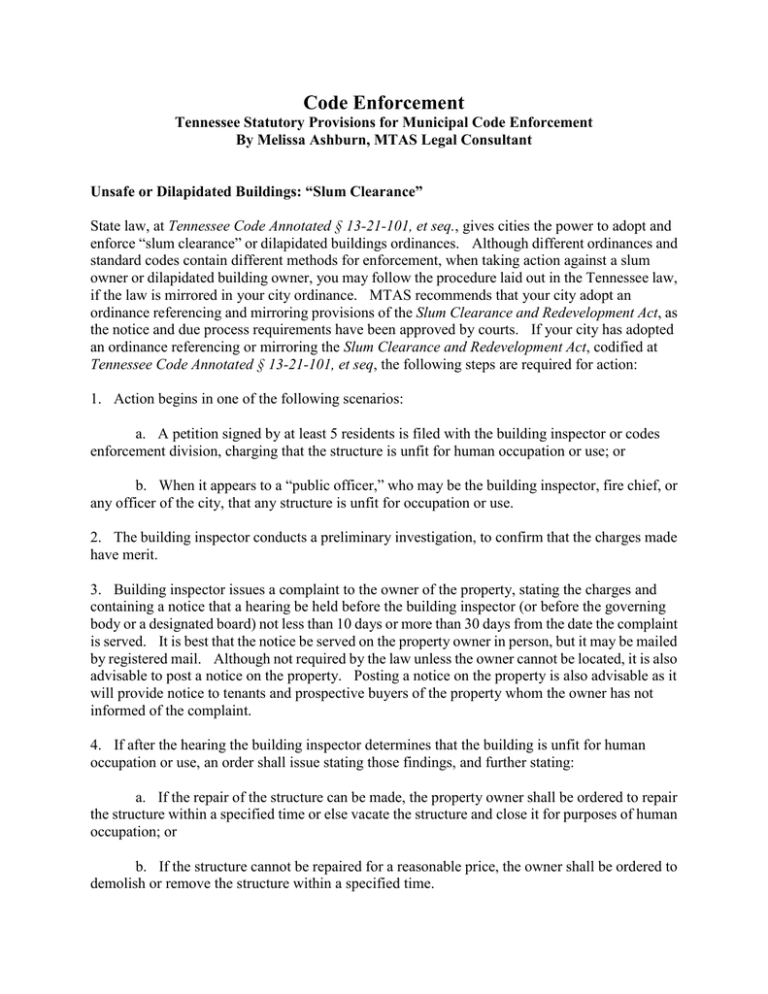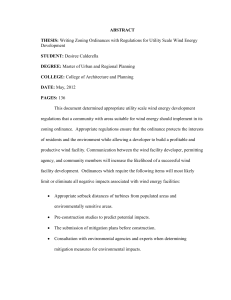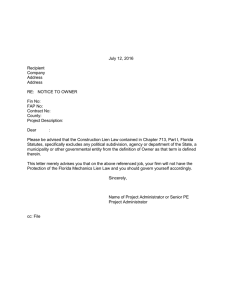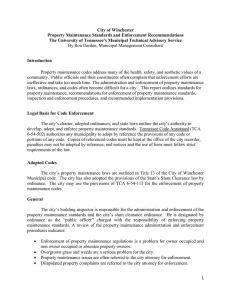Code Enforcement
advertisement

Code Enforcement Tennessee Statutory Provisions for Municipal Code Enforcement By Melissa Ashburn, MTAS Legal Consultant Unsafe or Dilapidated Buildings: “Slum Clearance” State law, at Tennessee Code Annotated § 13-21-101, et seq., gives cities the power to adopt and enforce “slum clearance” or dilapidated buildings ordinances. Although different ordinances and standard codes contain different methods for enforcement, when taking action against a slum owner or dilapidated building owner, you may follow the procedure laid out in the Tennessee law, if the law is mirrored in your city ordinance. MTAS recommends that your city adopt an ordinance referencing and mirroring provisions of the Slum Clearance and Redevelopment Act, as the notice and due process requirements have been approved by courts. If your city has adopted an ordinance referencing or mirroring the Slum Clearance and Redevelopment Act, codified at Tennessee Code Annotated § 13-21-101, et seq, the following steps are required for action: 1. Action begins in one of the following scenarios: a. A petition signed by at least 5 residents is filed with the building inspector or codes enforcement division, charging that the structure is unfit for human occupation or use; or b. When it appears to a “public officer,” who may be the building inspector, fire chief, or any officer of the city, that any structure is unfit for occupation or use. 2. The building inspector conducts a preliminary investigation, to confirm that the charges made have merit. 3. Building inspector issues a complaint to the owner of the property, stating the charges and containing a notice that a hearing be held before the building inspector (or before the governing body or a designated board) not less than 10 days or more than 30 days from the date the complaint is served. It is best that the notice be served on the property owner in person, but it may be mailed by registered mail. Although not required by the law unless the owner cannot be located, it is also advisable to post a notice on the property. Posting a notice on the property is also advisable as it will provide notice to tenants and prospective buyers of the property whom the owner has not informed of the complaint. 4. If after the hearing the building inspector determines that the building is unfit for human occupation or use, an order shall issue stating those findings, and further stating: a. If the repair of the structure can be made, the property owner shall be ordered to repair the structure within a specified time or else vacate the structure and close it for purposes of human occupation; or b. If the structure cannot be repaired for a reasonable price, the owner shall be ordered to demolish or remove the structure within a specified time. This order should be served on the property owner in the same manner as the original notice, either given to the owner personally or mailed by registered mail. It is also best to post the order on the premises. 5. If the owner fails to comply with the order, the city may demolish or repair the structure. The building official shall place a notice on the structure, stating: “This building is unfit for human occupation or use. The use or occupation of this building for human occupation or use is prohibited and unlawful.” These specific words are required to be posted by the statute. 6. If the city repairs or demolishes the structure, the city may place a lien against the property, simply by filing a notice with the register of deeds. Such a lien is second only to taxes. These liens may be collected by the city tax collector or county trustee at the same time property taxes are collected, and the same interest and penalties apply to the lien amount as are applied to delinquent taxes. If your city code does not follow the Slum Clearance and Redevelopment Act, the lien will not be automatic, but will require court action to attach it to the property. What if the property owner disagrees and wants to appeal the building inspector’s findings? - Property owners are always entitled to appeal the decisions of administrative employees of the city. Ordinances may state that the building official’s findings may be appealed to the city council or a different board. If no board is specified by your code, the property owner is entitled to appeal directly to your governing body. The Slum Clearance and Redevelopment Act contains a section permitting a property owner to file suit in chancery court to stop enforcement of an order issued by a building official. T.C.A. § 13-21-106. Who must be served with notice? - Any person who has an interest in the property, including the property owner noted on the tax assessor’s roles, as well as all mortgage holders. The register of deed’s office should be consulted concerning all filings relating to the property, and all mortgage holders must be put on notice of the proceedings. What if the property owner cannot be located? - Mail notices to the last known address by registered mail. Publish the notice in the paper of general circulation in your area for 2 consecutive weeks. Post a notice in a visible location on the property. The building official should also make an affidavit documenting his or her efforts to locate the owner and serve the notice. Each of these steps is required by the Slum Clearance and Redevelopment Act when the owner cannot be located and served. T.C.A. § 13-21-105. Why should a city adopt an ordinance under the Slum Clearance and Redevelopment Act, when other model code provisions apply to such structures? - One benefit of adopting an ordinance under this act, as supplemental to the model building code provisions, is the provision allowing the city to attach a lien for expenses incurred in enforcement when the property owner refuses to comply. When acting under model codes or ordinances which differ from this statute, a separate legal action is required in state court in order to attach a lien to the property. Another benefit is the courts’ approval of the process outlined in this Act. [Thomas v. Chamberlain, 143 F. Supp. 671 (E.D. Tenn. 1955), aff’d 236 F.2d 417(6th Cir. 1956); Winters v. Sawyer, 463 S.W.2d 705 (Tenn. 1971)]. If the city follows the requirements of the Act it will have a strong defense to any legal challenge raised by the property owner. Overgrown and Dirty Lots Tennessee law gives cities the power to force property owners to clean up overgrown and trashy lots, and the ability to mow and clean such lots if the owners refuse. Tennessee Code Annotated § 6-54-113 permits municipalities to adopt ordinances forbidding property owners from allowing their land to become overgrown with vegetation or from collecting trash and debris. The ordinance adopted by a city to enforce such powers must contain a statement of the conditions the city prohibits. The statute contains the following description, but a more detailed or different description may be used, as long as the basic meaning is the same. The statute authorizes a municipality to take action when it determines a property owner has: created, maintained or permitted to be maintained on such property the growth of trees, vines, grass, underbrush and/or the accumulation of debris, trash, litter, or garbage, or any combination of the preceding elements, so as to endanger the health, safety or welfare of other citizens or to encourage the infestation of rats and other harmful animals... T.C.A. § 6-54-113(b). Cities may designate a specific height of grass which would be considered a violation. The ordinance must further designate an official or a department for enforcement. Ordinances adopted under T.C.A. § 6-54-113 may be enforced against owner-occupied properties, under an amendment made to the law in 2007. A city may not levy a lien against owner-occupied properties, however, until the amount of remediation or clean up meets or exceeds $500. When adopting an ordinance under T.C.A. § 6-54-113, the steps to be taken for enforcement of the ordinance must be specified. Following is a description of those steps, based on the statute: 1. The designated department or person determines that conditions exist on the property which are prohibited by the ordinance, and prepares a notice to send to the property owner, stating: a. The condition complained of and the consequences for failing to remedy the condition, including the time period in which action must be taken and a statement that the city will take action if the owner fails to do so, and will collect the costs for the clean up from the owner; b. The name of the office, address, and telephone number of the department or the person giving the notice; c. An estimate of the costs for cleaning up the problem; and d. A place for the property owner to return the notice and request a hearing. 2. If the property owner fails to remedy the situation and clean up the lot within 10 days after receiving the notice, the city may take action to clean up the lot. Note: If the owner of record is a truck driver or otherwise employed in the transportation industry, the notice required is 20 days, excluding Saturdays, Sundays and legal holidays, before action may be taken by the city. 3. The city may collect the costs incurred in cleaning up or mowing a lot in 2 ways: a. By filing suit in circuit or chancery court to collect the costs as a debt owed. This may take the form of a garnishment suit; or b. By filing a lien against the property with the register of deeds. The amount of the lien may be collected by the tax collector or county trustee in the same manner as taxes are collected, and the costs are subject to the same interest and penalties as delinquent taxes. For owner-occupied properties, no lien may be filed until the debt owed equals or exceeds $500.




